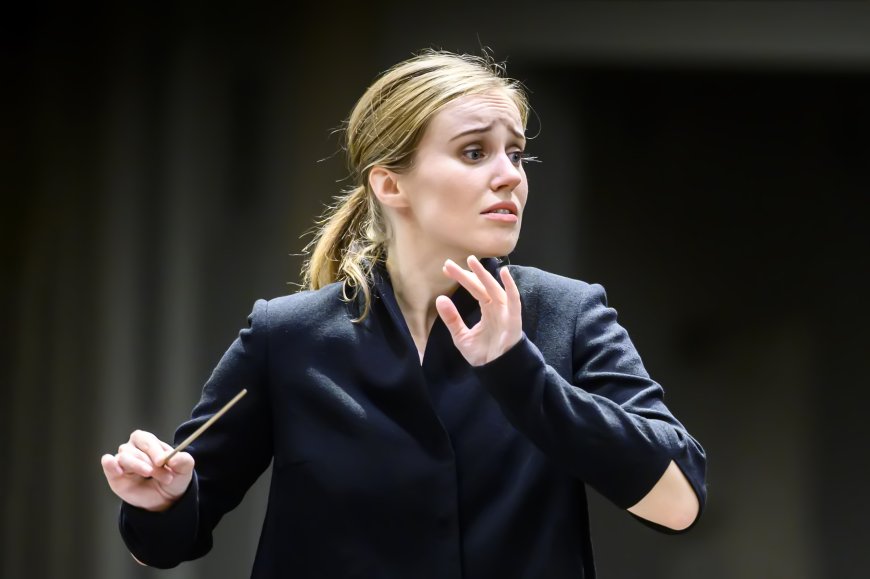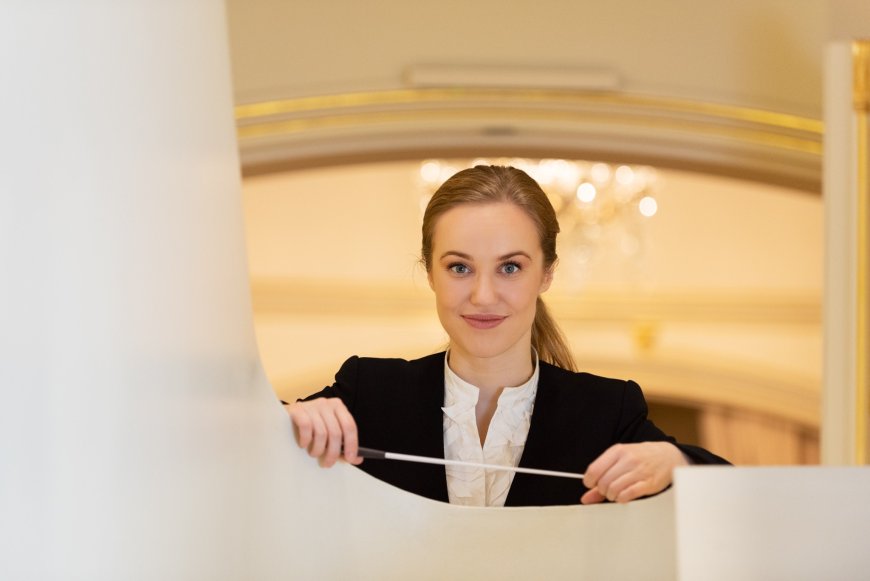
Lithuanian conductor Giedrė Šlekytė is set to make her Los Angeles Philharmonic debut at the Hollywood Bowl on August 26 in an all-Beethoven program. Indeed, it’s been a season of debuts for the 35-year-old maestra.
In 2023, Šlekytė conducted a Brahms symphony cycle in Toronto with the Staatskapelle Berlin, marking both her Canadian and North American debuts. Of that performance, Classical Voice North America’s Paul Robinson wrote, “Quite simply, she is a major talent and one of the most exciting conductors I have seen or heard in years.”
In January of this year, Šlekytė made her U.S. debut with the Dallas Symphony Orchestra. During the 2024–2025 season alone, she conducted La bohème at Vienna’s Wiener Staatsoper and Hansel and Gretel at London’s Royal Opera House. She also returned to Vienna’s Theater an der Wien for Schumann’s oratorio Das Paradies und die Peri, and took to the Staatsoper Berlin podium again for Bizet’s The Pearl Fishers.
Born in Vilnius, Lithuania, Giedrė Šlekytė began her musical education at the National M. K. Čiurlionis School of Art for students ages 7–19. She then studied conducting at the University of Music and Performing Arts Graz before attending the University of Music and Theatre Leipzig and the Zurich University of the Arts.

In 2016, the musician was appointed first Kapellmeister at Stadttheater Klagenfurt, where she led her first production — Mozart’s The Abduction from the Seraglio. After finishing her appointment, Šlekytė chose a freelance career as a conductor and has since been successfully proving herself on both operatic and symphonic stages.
San Francisco Classical Voice caught up with Šlekytė from Klagenfurt, a city in southern Austria that she now calls home. Topics discussed included her upcoming Bowl debut, how she prepares for a concert, and what it was like attending master classes with Bernard Haitink and Riccardo Muti.
You only recently made your U.S. debut with the Dallas Symphony Orchestra — how excited are you to lead the LA Phil at the Hollywood Bowl?
I am very excited, very. In fact, my Dallas debut was also the first time for me to enter the U.S. at all. I haven’t even been there as a tourist. This, for me, is still part of the world that is undiscovered. I spent all my life in Europe, [because] the biggest part of my professional career is in Europe. This is something really new for me. The Bowl seems to be an indescribably enormous venue [and] I’m looking forward to seeing it. It looks amazing.
You’ll be leading an all-Beethoven program, culminating in his “Eroica” symphony. Why do you think Beethoven continues to attract such huge and devoted audiences to this day?
[It’s] the energy that is unbeatably strong and raw. Beethoven’s music has this kind of directness and honesty — it doesn’t have any filter. It’s revolutionary in the way he develops a symphony, [as] all music lovers know. I still get the same effect about how fresh it still sounds to us today — and how surprising! One of the strongest features in Beethoven’s music is the way he uses momentum. It’s important how you prepare the momentum of some musical ideas.
[The concert] has quite a few parallels between the pieces that make this program very well-rounded. There’s heroism in the Egmont and Eroica. [There’s also] the theme of death in Egmont, obviously, and the incredible “Marcia funebre” in the second movement of the Eroica. We have also a kind of funeral march in the second movement of the piano concerto. It’s not marked this way, but it does have this character of the death’s world. Also, the three pieces end in a kind of triumphal music. Even though there’s death, there’s something stronger.
How do you prepare for a concert? What’s your process?
I buy a score. I research which edition is the best. I read the preface of the score I bought. I open the score and look what is inside and study it. A lot of [my] process is quite a practical one. First, there’s the normal studying — what is this piece, what is it about? The truly artistic and more exciting interpretational process comes at the end. I think many people imagine that from the very first second it’s an artistic process. But there is a lot of practical work in that.
There must have been a practical side to your also having attended master classes with Bernard Haitink and Riccardo Muti at the Lucerne Festival. What did you learn from them?
These weeks were extremely influential in my life. Not only did I get a lot of useful impulses during these classes — that was the most important thing — but I had the possibility to go to incredible concerts. I got to hear the LA Phil live then and was very impressed. They were playing The Rite of Spring. I would sneak into rehearsals with [Claudio] Abbado and [Mariss] Jansons and soloists like Martha Argerich. All the legends, every day the crème de la crème of the music world [were there].
It’s interesting that you mention these classes. I had three times with Haitink. I did the Eroica and remember it very well [because] he said that my enthusiasm was refreshing in this hard business world. I was very satisfied and remember that moment.

[Riccardo] Muti — I was thinking about how the opposite of the masterclass was between Bernard and him. Bernard is someone who lets musicians play a lot. His influence is in such small, very simple moments, but he leaves a lot of freedom. Muti was very, very decisive in every tone, exactly the opposite [of Haitink]. He was conducting La traviata by Verdi, his field of expertise. It was very informative.
What do you think makes for good chemistry between a conductor and an orchestra?
The word “chemistry,” that’s the key. Sometimes I wonder why does it work so well with one orchestra and with another not as well — and not only for myself. I’m a very passionate audience member. I have experienced so often great conductors and great orchestras not getting along at all.
That doesn’t mean anything about quality, [but] it’s something hard to explain. Thankfully, I’ve had quite positive and varying experiences, and there have been several good experiences upon which I can further my relationship with [orchestras]. Just like in real life, you don’t need to become best friends with every person. It clicks and the great thing is you can work with them again.
One of your colleagues, Mirga Gražinytė-Tyla, is also from Lithuania. Would you say that you and she are on a mission to make people more aware of Lithuanian music?
Mirga and I went to the same school. She was four years older [and] graduated when I was in the 8th grade. I remember that she was absolutely the best. Her creativity didn’t have any limits. She’s still continuing to be like that. I absolutely love her [and] traveled extra when she did her debut with the Vienna Philharmonic [in May 2025], because I couldn’t miss it. In these concerts, she was performing a work by Raminta Šerkšnytė, a [Lithuanian] composer we recorded together on an album published by Deutsche Grammophon.
Mirga is a good friend, and I have also collaborated with Raminta many times. Many people don’t know Lithuania at all. So am I on a mission? Yes, I am. There are many exciting creators in Lithuania. The scene is very vivid. It’s something that I didn’t announce as my mission, but it comes naturally for me.
